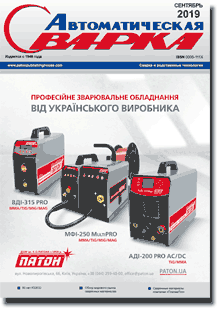| 2019 №09 (03) |
DOI of Article 10.15407/as2019.09.04 |
2019 №09 (05) |

Avtomaticheskaya Svarka (Automatic Welding), #9, 2019, pp. 31-39
Heat-resistant thermal coatings based on FeAlCr intermetallics with CeO2 additives
Yu.S. Borisov1, A.L. Borisova1, T.V. Tsymbalista1, N.I. Kaporik1, M.A. Vasilkovskaya2
1E.O. Paton Electric Welding Institute of the NAS of Ukraine, 11 Kazimir Malevich Str., 03150, Kyiv, Ukraine. E-mail: office@paton.kiev.ua
2Frantsevich Institute for Problems of Material Science, 3 Krzhizhanovskogo Str, 03680, Kyiv, Ukraine. E-mail: kiparis-gpk@ukr.net
The paper presents the results of studying the heat resistance of coatings, produced by the methods of plasma (PS) and high-speed flame spraying (HSFS), using composite powder based on FeAlCr with addition of 2 wt.% CeO2, as well as by the methods of arc spraying (AS) and activated arc spraying (AAS) with application of flux-cored wire of the following composition 98(82Fe+16Al+2Cr)+2CeO2 (wt.%). Composite powder was prepared by the method of mechanico-chemical synthesis (MChS) by treating a mixture of powder components in a planetary-type mill. Heat-resistance testing was performed in air at 800, 900 and 1000 °C for 7 hours by weight method. Coating structure after heat-resistance testing was studied with application of metallographic and X-ray structural analysis (RSPhA). It is found that during testing of coatings produced by PS and HSFS methods the delamination phenomenon is observed, whereas coatings produced by AS and AAS methods preserve a tight bond with the base. Obtained kinetic curves of high-temperature resistance showed that in the entire time interval of testing at 800 – 1000 °C the oxidation mechanism follows the parabolic law. The data of kinetic dependencies were used to plot the parametric heat resistance diagrams, allowing evaluation of fatigue life of the studied protective coatings in the temperature range of 800 – 1000 °C. The highest heat resistance is found in FeAlCrCeO2 coatings produced by AS and AAS methods from flux-cored wire. At 1000 °C it exceeds the resistance of steel 45 23-26 times, and corresponds to heat resistance of 08Kh17T steel. 12 Ref., 2 Tabl., 8 Fig.
Keywords: flame spraying, arc spraying, iron-aluminium intermetallics, mechanico-chemical synthesis, composite powder, flux-cored wire, parametric heat-resistance diagram, FeAlCr-CeO2 system
Received: 12.06.2019
References
1. Deevi, S.C., Sikka, V.K. (1996) Nickel and iron aluminides: An overview on properties, processing, and applications. Intermetallics, 4(5), 357-375. https://doi.org/10.1016/0966-9795(95)00056-92. Kai, W., Lee, S.H., Chiang, D.L.,Chu, J.P. (1998) The hightemperature corrosion of Fe-28Al and Fe-18Al-10Nb in a H2/H2S/H2O gas mixture. Materials Sci. and Eng. A, 258(1-2), 146-152. https://doi.org/10.1016/S0921-5093(98)00927-7
3. Wei, S., Xu, B., Wang, H. et al. (2007) High-temperature corrosion-resistance performance of electro-thermal explosion plasma spraying FeAl-base coatings. Surface and Coatings Technology, 201(15), 6768-6771. https://doi.org/10.1016/j.surfcoat.2006.09.122
4. Tortorelli, P.F., Natesan, K. (1998) Critical factors affecting the high-temperature corrosion performance of iron aluminides. Materials Sci. and Eng. A, 258(1-2), 115-125. https://doi.org/10.1016/S0921-5093(98)00924-1
5. Ignatov, D.V., Lazarev, E.M., Abramova, N.V. (1974) Effect of rare-earth metals on kinetics and oxidation mechanism of nickel-chromium-based alloys. In: Influence of physicochemical medium on high-temperature resistance of metallic materials. Moscow, Nauka, 68-72 [in Russian].
6. Nagai, H., Takebayashi, Y., Mitani, H. (1981) Effect of dispersed oxides of rare earths and other reactive elements on the high temperature oxidation resistance of Fe-20Cr alloy. Metallurgical and Materials Transact. A, 12(3), 435-442. https://doi.org/10.1007/BF02648540
7. Xingwei, M., Zhuji, J., Shi, Y., Jiujun, X. (2009) Effect of La2O3 on microstructure and high-temperature wear property of hot-press sintering FeAl intermetallic compound. J. of Rare Earths, 27(6), 1031-1036. https://doi.org/10.1016/S1002-0721(08)60383-X
8. Wang, Y., Yan, M. (2006) The effect of CeO2 on the erosion and abrasive wear of thermal sprayed FeAl intermetallic alloy coatings. Wear, 261, 1201-1207. https://doi.org/10.1016/j.wear.2006.03.039
9. Xiao, Ch., Chen, W. (2006) Sulfidation resistance of CeO2-modified HVOF sprayed FeAl coatings at 700 °C. Surface and Coatings Technology, 201, 3625-3632. https://doi.org/10.1016/j.surfcoat.2006.08.138
10. Magnee, A., Offergeld, M., Leroy, A. Lefort, A. (1998) FeAl intermetallic coatings applications to thermal energy conversion advanced systems. In: Proc. of the 15th ITSC, France, Nice, 1091-1096.
11. Nikitin, V.I. (1976) Calculation of heat resistance of metals. Moscow, Metallurgiya [in Russian].
12. Nikitin, V.I. (1981) Method of prediction of life of protective coatings. Fiz.-Khimich. Mekhanika Materialov, 3, 95-99 [in Russian].
